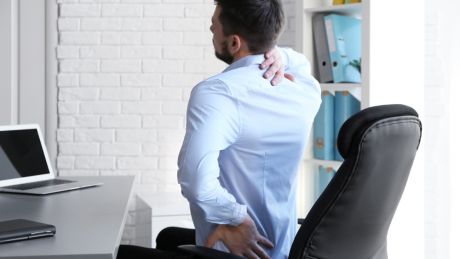Are You Sitting Comfortably? How To Perfect Your Posture
Prevent long-term posture issues developing with this expert advice

All too often it takes a problem to arise before people will do any work to correct their bad posture. Instead of sitting – or indeed slouching – there, waiting for lower back or neck pain to develop and then working on your posture, put in some preventative work now and hopefully you’ll avoid such issues altogether.
We spoke to Joseph Badham, Beyond Movement team lead at Virgin Active Fulham Pools, about the issues poor posture causes, and how people can prevent and treat them.
What are the most common problems you see?
When people hear the term posture they tend to immediately think of their backs, but it’s actually another part of the body that causes the most problems.
“The most common complaints are neckaches which are associated with headaches,” says Badham.
“Secondly we see a lot of lower back pain, which is often to do with the core muscles not firing. Thirdly we see a lot of shoulder pain, again connected to the neck and alignment of the spine, which comes as a result of prolonged periods sitting at a desk.”
What are the long-term issues associated with poor posture?
Many people feel the aches and pains of poor posture every time they leave their desk at the end of a long day, but choose to ignore those issues for years. Needless to say, this is a bad idea.
“Typically the outcome is prolonged shoulder, neck or lower back pain. Most commonly, poor posture leads to lower back pain which can become a problem later in life,” says Badham.
Get the Coach Newsletter
Sign up for workout ideas, training advice, reviews of the latest gear and more.
“We see a lot of people come in with lower back pain because it has prevented them doing the exercise that they enjoy. So many people fall into the trap of ignoring these symptoms until eventually the pain stops them from doing what they want to do – whether this is picking up their children or playing sport.”
What kind of exercises should people be doing to correct posture issues?
“The best exercises for people beginning to develop pain are movements associated with mobility that focus on building strength around the area in distress,” says Badham.
“For example, with your lower back, we’d focus on the hips and the lower back by treating symptoms with prescribed foam rolling and stretching. Alongside that, we recommend exercises that trigger glute activation and core strength to build stability around the key lumbar area.
“With shoulders we would focus on upper back and neck mobility and concentrate on creating strength around the shoulders and rotator cuff. If you’ve got good mobility and muscle balance then you stand a much better chance of not developing pain or other common complaints.”
If you are keen on strengthening your core muscles and working on your overall mobility and flexibility with the aim of improving your posture, you could do far worse than giving Pilates a try.
“Reformer Pilates is great to correct posture issues because it challenges the core, and the muscles around the lower back and the shoulder areas,” says Badham. “It’s practised against a sliding platform and performed against sprung resistance, which really targets the desired muscles.
“Some people prefer yoga to Pilates; they are very closely related but it depends on what sort of approach you like to take.”
If you have specific concerns related to your posture you can also visit a physio for personalised advice.
“If you have good mobility and good strength you are in the best position to act preventatively rather than reactively to posture issues. At a Beyond Movement consultation we are able to provide an array of bespoke exercises which focus on hip mobility and lumbar mobility,” says Badham.
Beyond Movement comprises reformer Pilates, physiotherapy and sports massage, and is available to members and non-members at Virgin Active Strand, Fulham and Barbican clubs.

Nick Harris-Fry is a journalist who has been covering health and fitness since 2015. Nick is an avid runner, covering 70-110km a week, which gives him ample opportunity to test a wide range of running shoes and running gear. He is also the chief tester for fitness trackers and running watches, treadmills and exercise bikes, and workout headphones.
